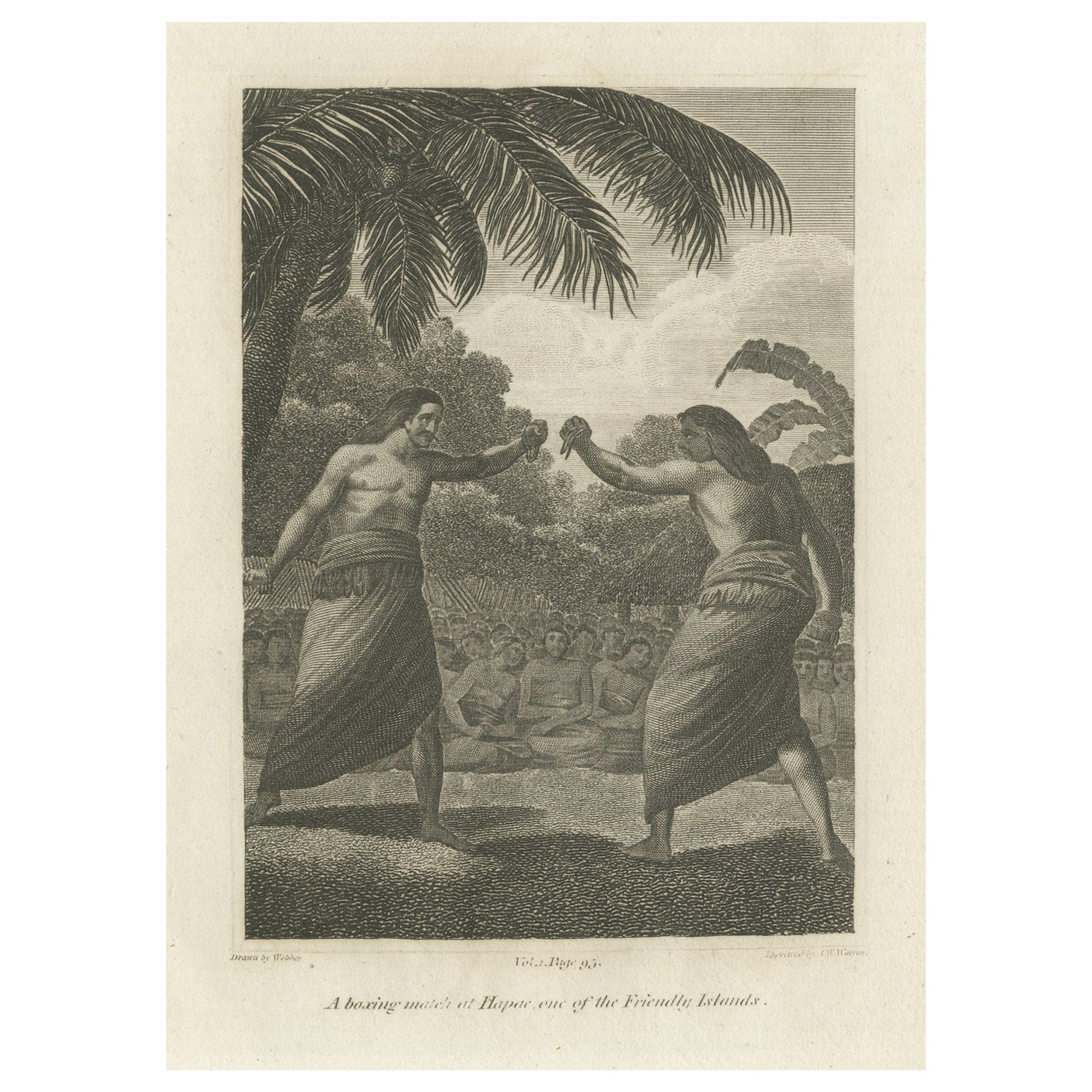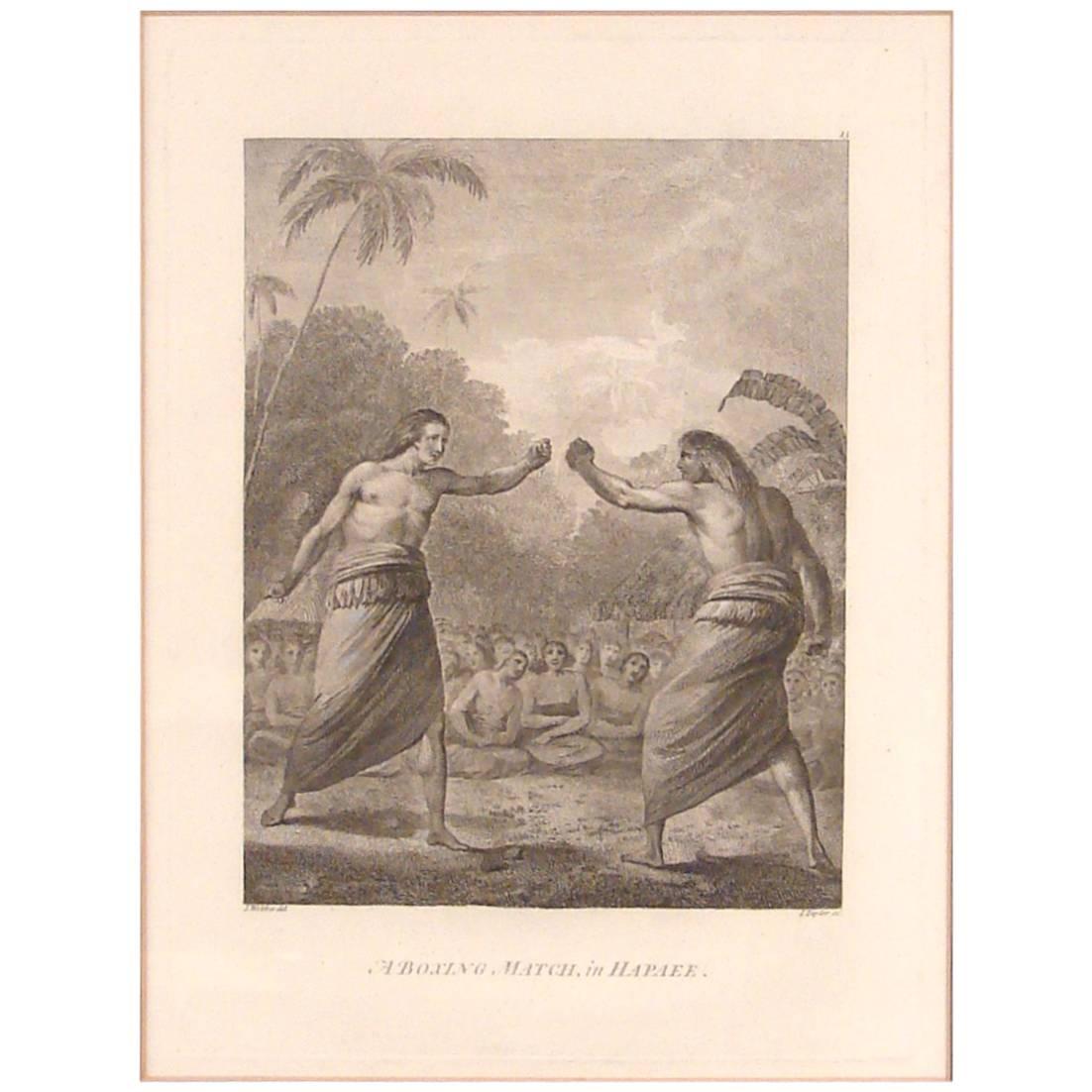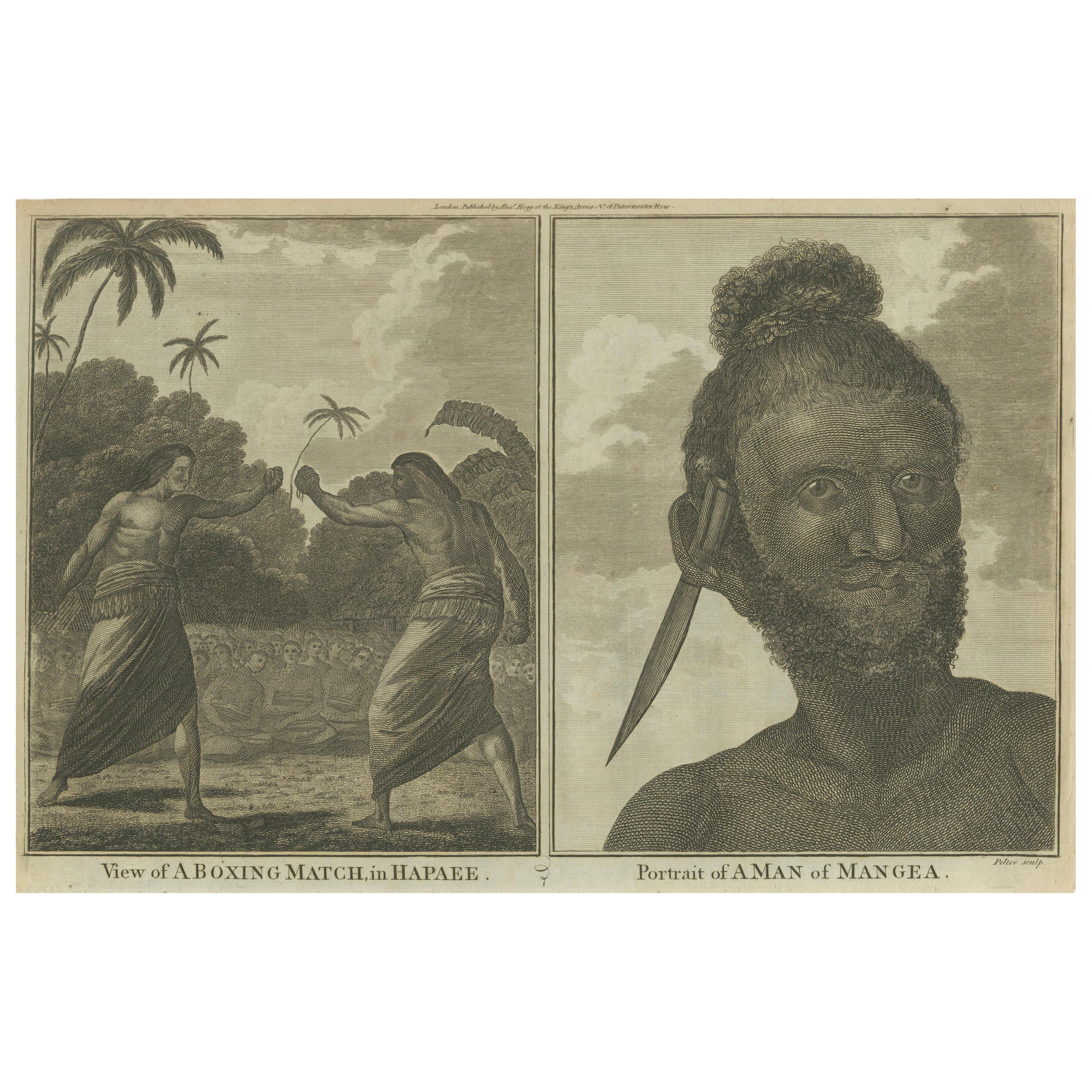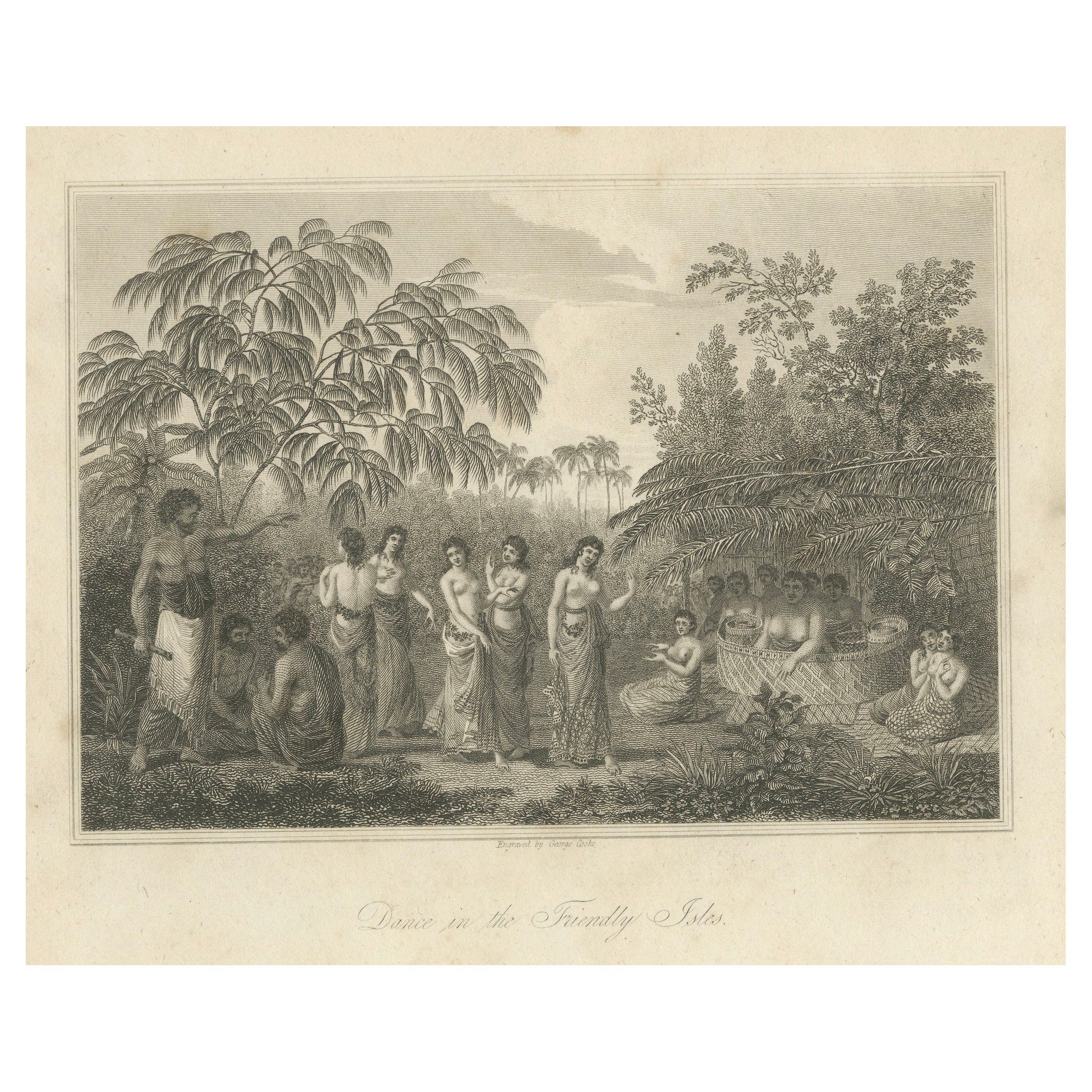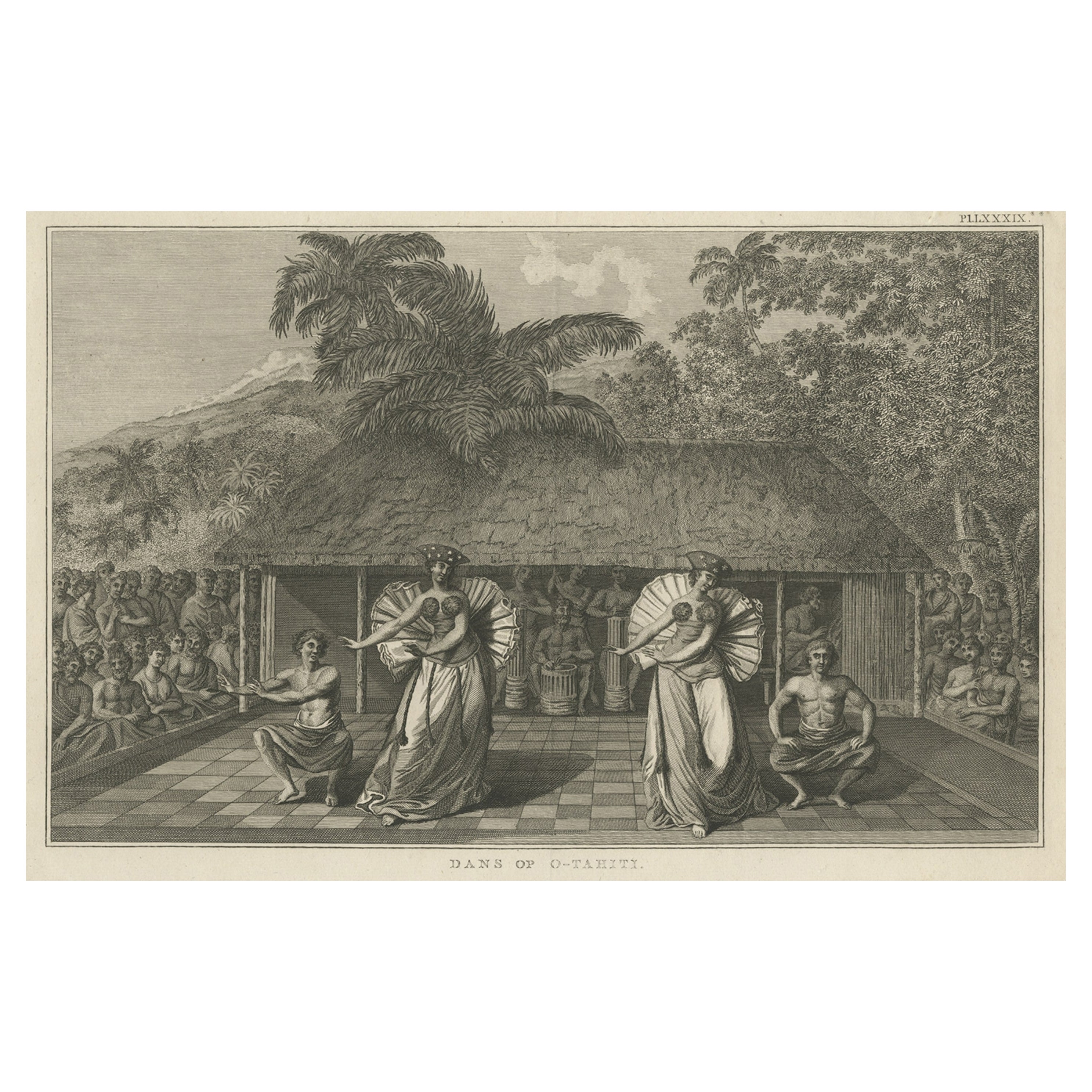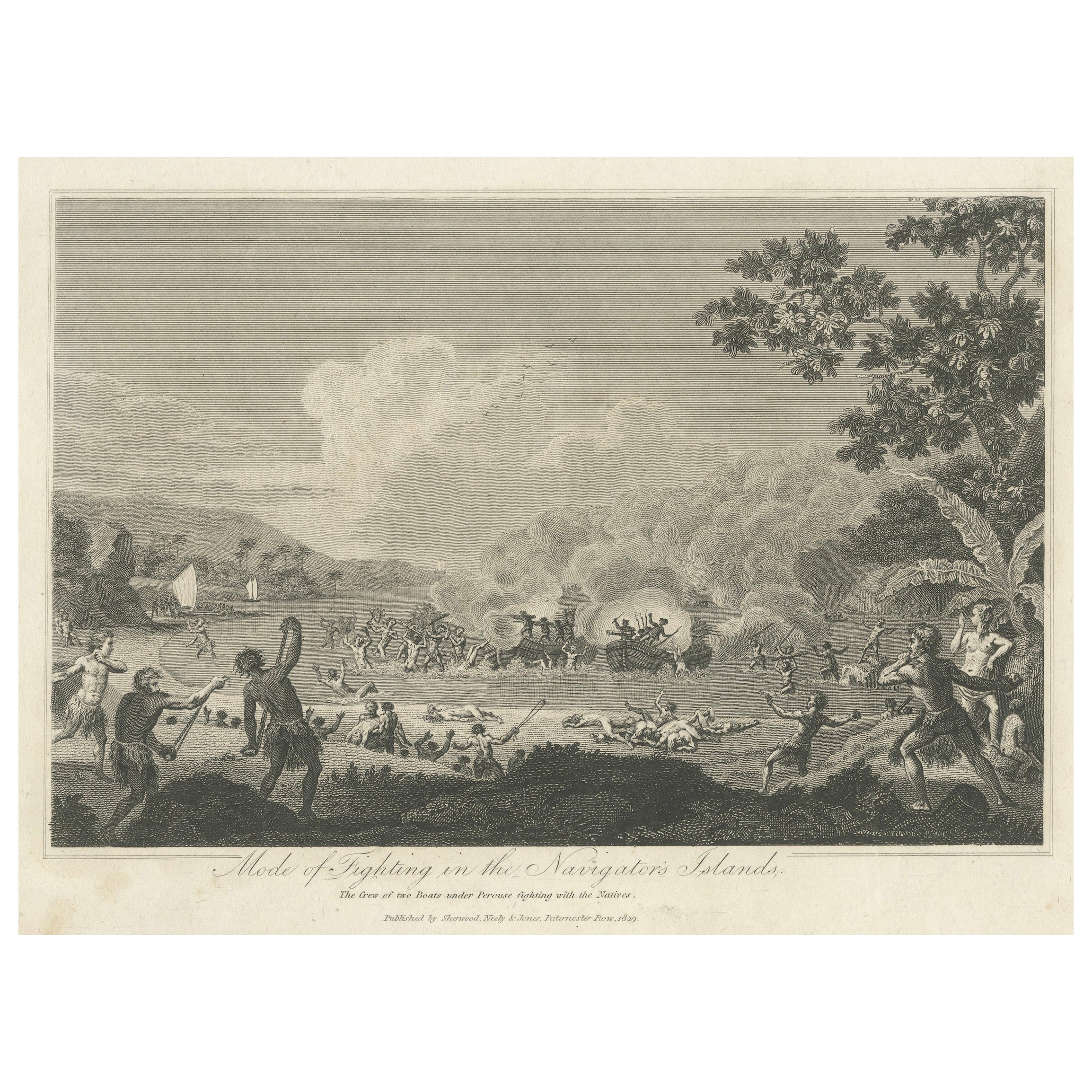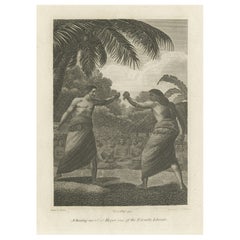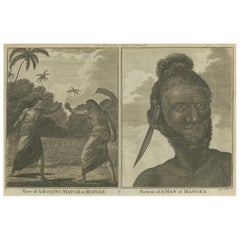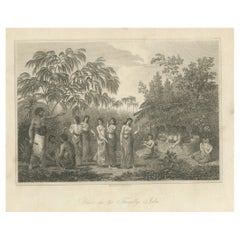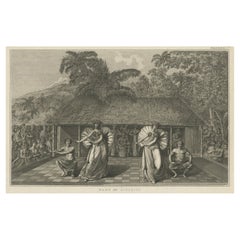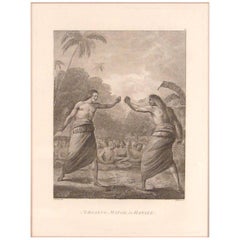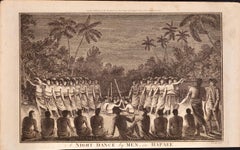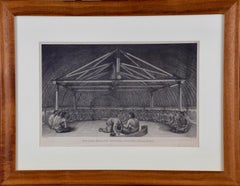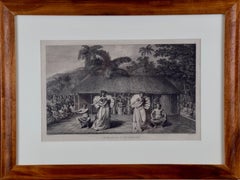Items Similar to Old Print of a Boxing Fight Between Two Natives of Hapaee, Tonga Islands, 1803
Want more images or videos?
Request additional images or videos from the seller
1 of 6
Old Print of a Boxing Fight Between Two Natives of Hapaee, Tonga Islands, 1803
$246.55
$308.1820% Off
£184.63
£230.7920% Off
€208
€26020% Off
CA$345.04
CA$431.3120% Off
A$378.31
A$472.8920% Off
CHF 197.55
CHF 246.9420% Off
MX$4,552.53
MX$5,690.6620% Off
NOK 2,489.83
NOK 3,112.2920% Off
SEK 2,341.08
SEK 2,926.3520% Off
DKK 1,584.44
DKK 1,980.5520% Off
About the Item
Antique print titled 'Vuist-Gevegt van de Inboorlingen van Hapaee'.
Antique print depicting a fight between two natives of Hapaee. Originates from 'Reizen Rondom de Waereld door James Cook (..)'.
Ha'apai is one of the islands of Tonga, where Webber sketched the locals and their customs. The entertainment was provided for Cook and his crew on the beach upon his arrival on the Island. Cook remarked in his account that the boxing closely resembled that of England and the wrestling matches that also occurred were of the "same manner" as seen in Tahiti.
Artists and Engravers: Translated by J.D. Pasteur. Published by Honkoop, Allart en Van Cleef.
- Dimensions:Height: 9.06 in (23 cm)Width: 5.91 in (15 cm)Depth: 0 in (0.02 mm)
- Materials and Techniques:
- Period:1800-1809
- Date of Manufacture:1803
- Condition:Wear consistent with age and use. Condition: Very good, please study image carefully.
- Seller Location:Langweer, NL
- Reference Number:Seller: BG-11487-156 1stDibs: LU3054327163132
About the Seller
5.0
Recognized Seller
These prestigious sellers are industry leaders and represent the highest echelon for item quality and design.
Platinum Seller
Premium sellers with a 4.7+ rating and 24-hour response times
Established in 2009
1stDibs seller since 2017
2,668 sales on 1stDibs
Typical response time: <1 hour
- ShippingRetrieving quote...Shipping from: Langweer, Netherlands
- Return Policy
Authenticity Guarantee
In the unlikely event there’s an issue with an item’s authenticity, contact us within 1 year for a full refund. DetailsMoney-Back Guarantee
If your item is not as described, is damaged in transit, or does not arrive, contact us within 7 days for a full refund. Details24-Hour Cancellation
You have a 24-hour grace period in which to reconsider your purchase, with no questions asked.Vetted Professional Sellers
Our world-class sellers must adhere to strict standards for service and quality, maintaining the integrity of our listings.Price-Match Guarantee
If you find that a seller listed the same item for a lower price elsewhere, we’ll match it.Trusted Global Delivery
Our best-in-class carrier network provides specialized shipping options worldwide, including custom delivery.More From This Seller
View AllA Boxing Match, in Hapaee, One of the Hawaii Islands, circa 1780
Located in Langweer, NL
John Webber created the engraving titled "A Boxing Match, in Hapaee, one of the Friendly Islands." Webber was indeed an artist who accompanied Captain James Cook on his third voyage ...
Category
Antique Late 18th Century English Prints
Materials
Paper
Traditions and Faces of the Pacific: Boxing in Ha'apai and a Man of Mangea, 1785
Located in Langweer, NL
The engraving appears to be from the Captain James Cook's voyages, which took place between 1768 and 1779. Since it is related to Cook's expeditions and given the style of the engrav...
Category
Antique 1780s Prints
Materials
Paper
$208 Sale Price
20% Off
Rhythms of the Pacific: A Communal Dance in Tonga, Engraving Published in 1812
Located in Langweer, NL
The engraving depicts a serene and communal scene labeled as "Dance in the Friendly Isles." The Friendly Isles is an older name for the Kingdom of Tonga in the South Pacific. This pi...
Category
Antique Early 19th Century Prints
Materials
Paper
$246 Sale Price
20% Off
Free Shipping
Antique Copper Plate Engraving Depicting Natives of Tahiti Dancing, 1803
Located in Langweer, NL
Antique print titled 'Dans van O-Tahiti'.
Antique print depicting natives of Tahiti, dancing. Originates from 'Reizen Rondom de Waereld door James Cook (..)'.
Artists and Eng...
Category
Antique Early 1800s Prints
Materials
Paper
$331 Sale Price
20% Off
Confrontation and Culture: Samoan Warrior Engagement, Published in 1820
Located in Langweer, NL
The engraving is captioned as "Mode of Fighting in the Navigator's Islands" and depicts a scene of conflict among the indigenous people of the Navigator's Islands, now known as the ...
Category
Antique 1820s Prints
Materials
Paper
$237 Sale Price
20% Off
Free Shipping
Antique Print of a Kava Ceremony on Tonga Tabu, c.1836
Located in Langweer, NL
Antique print titled 'Die Ceremonie des Kava bei dem Häuptling Palu'. Old print depicting a Kava Ceremony on Tonga Tabu. This print originates from 'Entdeckungs, Reise der Franzosischen Corvette Astrolabe Unternomen auf Befehl Konig Karls...
Category
Antique 19th Century Prints
Materials
Paper
$312 Sale Price
20% Off
You May Also Like
Copper Engraving "Boxing Match in Hapaee from Cook's Voyages" after John Webber
By John Webber
Located in San Francisco, CA
J. Webber: A boxing match in Hapaee (Hawaii). An original copper plate engraving on paper depicting a boxing match as witnessed during Cook's third voyage...
Category
Antique 18th Century English Decorative Art
Materials
Paper
A Night Dance by Men in Tonga: An Original 18th C. Engraving, Cook's 3rd Voyage
By John Webber
Located in Alamo, CA
"A Night Dance by Men in Hapaee" is an original 18th century engraving from a drawing by John Webber (1751-1793), who was the artist who accompanied Captain Cook on his third voyage ...
Category
1780s Landscape Prints
Materials
Engraving
"King of the Friendly Islands" (Tonga); Engraving from Captain Cook's 3rd Voyage
By John Webber
Located in Alamo, CA
"Poulaho, King of the Friendly Islands, Drinking Kava" is an engraving created by William Sharp (1749-1824), from a drawing by John Webber (1752-1793), who was the artist on Captain James Cook's 3rd and final voyage of discovery. It was published in the atlas of "A Voyage to the Pacific Ocean Undertaken by the Command of His Majesty, for Making Discoveries in the Northern Hemisphere", the official British Admirality sanctioned journal published upon completion of the voyage in London in 1784 by Strahan & Cadell.
Captain Cook visited Tonga on his 3rd voyage, which he named The Friendly Islands because of the warm welcome he and his crew received, unlike some of the other more hostile Pacific islands. The engraving depicts Cook and his men observed a kava ceremony at the village of Mu’a on Tongatapu. King Paulaho sits in the centre foreground, his back to the spectator with a man kneeling before him. The ceremonial mat depicted behind Paulaho indicates that nobody was allowed to sit behind him. The figure in the centre holds a single cup, referring to the Tongan custom of offering the cup to the king first. Kava is native to the islands of the South Pacific and was first described for English readers in 1768 by Captain James Cook. The kava root has been used for centuries as a central feature of ceremonies and celebrations because it was able to bring about a calming and pleasant social atmosphere. The root was crushed and processed into coconut milk to become the focal ceremonial beverage, simply referred to as kava.
This engraving is presented in a Koa wood frame and a white mat. Koa wood is legendary in Hawaii. There are occasional faint spots, but the print is otherwise in very good condition. This amazing Koa wood is native to Hawaii and it is known for the deep rich colors and varied grain pattern. Koa has an honored heritage in Hawaii and is highly revered and sacred. The word “koa” means “warrior” in Hawaiian. The warriors of King Kamehameha the Great, created canoes and weapons from a wood plentiful on the Big Island of Hawaii. This wood became synonymous with the warriors themselves, and it became known as koa.
There are three other engravings listed from the official journal of Captain Cook's 3rd voyage available that are presented in identical Koa wood frames and mats (LU117324682422, LU117324684052, LU117324684032). They would make a wonderful grouping for a display of 2, 3 or 4 prints. A discount is available for a grouping depending on the number of items included.
Captain Cook is remembered as one of the greatest explorers and navigators in history. His explorations included Australia, New Zealand and islands of the South Pacific and the northwest coast of North America. Hawaii was discovered by Captain Cook during this voyage. Hawaii was originally called The Sandwich Islands in honor of The Earl of Sandwich...
Category
1780s Realist Figurative Prints
Materials
Engraving
"A Dance in Otaheite" (Tahiti), Engraving from Captain Cook's 3rd Voyage
By John Webber
Located in Alamo, CA
"A Dance in Otaheite" (Tahiti) is an engraving created by William Sharp (1749-1824), from a drawing by John Webber (1752-1793), who was the artist on Captain James Cook's 3rd and final voyage of discovery. It is a plate in the atlas of "A Voyage to the Pacific Ocean Undertaken by the Command of His Majesty, for Making Discoveries in the Northern Hemisphere", the official British Admirality sanctioned journal published upon completion of the voyage in London in 1784 by Strahan & Cadell.
Two women and two men wearing ceremonial costumes, performing a dance outdoors standing on a mat. Three men are playing the drums in the background, in front of a thatched roof building. An audience of men are sitting on both sides of the stage. By the time Webber arrived in Tahiti, 'south sea' imagery had become familiar. Webber gave concentrated attention to dance. He had the opportunity to distinguish the Tahitian dance from the more formalized dancing of Tonga. Whereas they seem to have called to mind the more formal dances of antiquity, the Tahitian dancing aroused memories of peasant and folk dancing.
This engraving is professionally framed in Koa wood. Koa wood is legendary in Hawaii. Not only is this amazing wood native to Hawaii, but it is known for the deep rich colors and varied grain pattern. Koa has an honored heritage in Hawaii and is highly revered and sacred. The word “koa” means “warrior” in Hawaiian. The warriors of King Kamehameha the Great, created canoes and weapons from a wood plentiful on the Big Island of Hawaii. This wood became synonymous with the warriors themselves, and it became known as koa.
The print is in excellent condition.
There are three other engravings listed from the official journal of Captain Cook's 3rd voyage available that are presented in identical Koa wood frames and double mats (LU117324682432, LU117324684052, LU117324684062). They would make a wonderful grouping for a display of 2, 3 or 4 prints. A discount is available for a grouping depending on the number of items included.
Hawaii was discovered by Captain Cook during this voyage. Hawaii was originally called The Sandwich Islands in honor of The Earl of Sandwich...
Category
1780s Realist Landscape Prints
Materials
Engraving
Guam, Convent and native inhabitants, mid 19th century lithograph. Oceania.
Located in Melbourne, Victoria
'Convento di agagna nell' Isola Guam. Occupazioni domestiche in Guam.'
Italian lithograph, c1841. Originally from 'Galleria universale di tutti i popoli del mondo' by Giuseppe Anton...
Category
Mid-19th Century Naturalistic Figurative Prints
Materials
Lithograph
Original Antique Ethnographical Print, Figures, New South Wales, Australia, 1809
Located in St Annes, Lancashire
Wonderful ethnographical print.
A copper-plate engraving after Lesieur
Published by Sherwood, Neely & Jones. Dated 1809
Unframed.
Category
Antique Early 1800s English Folk Art Prints
Materials
Paper
More Ways To Browse
Kage Farsta
Karges Regency
Khmer Sculpture
King Edward Viii
Korean Panel
Lion Silk
Living In Style Gallery
Louis Xiv Style Commode
Lyon Silk
Marble Lotus
Marble Relief Decorations
Marble Tray Large
Marble Wall Relief
Marble Washstand
Maurice Model
Mcguire Table And Chair Set
Michael Taylor For Baker Chest
Mid Century Nathan
